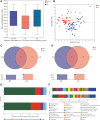Gut Microbiota May Play a Significant Role in the Pathogenesis of Graves' Disease
- PMID: 33234057
- PMCID: PMC8110022
- DOI: 10.1089/thy.2020.0193
Gut Microbiota May Play a Significant Role in the Pathogenesis of Graves' Disease
Abstract
Background: Gut microbiota are considered to be intrinsic regulators of thyroid autoimmunity. We designed a cross-sectional study to examine the makeup and metabolic function of microbiota in Graves' disease (GD) patients, with the ultimate aim of offering new perspectives on the diagnosis and treatment of GD. Methods: The 16S ribosomal RNA (rRNA) V3-V4 DNA regions of microbiota were obtained from fecal samples collected from 45 GD patients and 59 controls. Microbial differences between the two groups were subsequently analyzed based on high-throughput sequencing. Results: Compared with controls, GD patients had reduced alpha diversity (p < 0.05). At the phylum level, GD patients had a significantly lower proportion of Firmicutes (p = 0.008) and a significantly higher proportion of Bacteroidetes (p = 0.002) compared with the controls. At the genus level, GD patients had greater numbers of Bacteroides and Lactobacillus, although fewer Blautia, [Eubacterium]_hallii_group, Anaerostipes, Collinsella, Dorea, unclassified_f_Peptostreptococcaceae, and [Ruminococcus]_torques_group than controls (all p < 0.05). Subgroup analysis of GD patients revealed that Lactobacillus may play a key role in the pathogenesis of autoimmune thyroid diseases. Nine distinct genera showed significant correlations with certain thyroid function tests. Functional prediction revealed that Blautia may be an important microbe in certain metabolic pathways that occur in the hyperthyroid state. In addition, linear discriminant analysis (LDA) and effect size (LEfSe) analysis showed that there were significant differences in the levels of 18 genera between GD patients and controls (LDA >3.0, all p < 0.05). A diagnostic model using the top nine genera had an area under the curve of 0.8109 [confidence interval: 0.7274-0.8945]. Conclusions: Intestinal microbiota are different in GD patients. The microbiota we identified offer an alternative noninvasive diagnostic methodology for GD. Microbiota may also play a role in thyroid autoimmunity, and future research is needed to further elucidate the role.
Keywords: 16S rRNA sequencing; Graves' disease; alpha diversity; gut microbiota; metabolism.
Conflict of interest statement
The authors declare that they have no competing financial interests.
Figures




Similar articles
-
Correlations between serum cytokines and gut microbiota in patients with Graves' disease: A case-control study.Medicine (Baltimore). 2025 Jun 20;104(25):e43000. doi: 10.1097/MD.0000000000043000. Medicine (Baltimore). 2025. PMID: 40550033 Free PMC article.
-
Comparative assessment of gut microbial composition and function in patients with Graves' disease and Graves' orbitopathy.J Endocrinol Invest. 2021 Feb;44(2):297-310. doi: 10.1007/s40618-020-01298-2. Epub 2020 May 24. J Endocrinol Invest. 2021. PMID: 32449092
-
Alterations of Gut Microbiota in Patients With Graves' Disease.Front Cell Infect Microbiol. 2021 May 5;11:663131. doi: 10.3389/fcimb.2021.663131. eCollection 2021. Front Cell Infect Microbiol. 2021. PMID: 34026662 Free PMC article.
-
The Role of the Microbiota in Graves' Disease and Graves' Orbitopathy.Front Cell Infect Microbiol. 2021 Dec 22;11:739707. doi: 10.3389/fcimb.2021.739707. eCollection 2021. Front Cell Infect Microbiol. 2021. PMID: 35004341 Free PMC article. Review.
-
Significance of Gut Microbiota on Graves' Disease.Int J Gen Med. 2024 Sep 11;17:3967-3974. doi: 10.2147/IJGM.S467888. eCollection 2024. Int J Gen Med. 2024. PMID: 39281039 Free PMC article. Review.
Cited by
-
Gut Microbiome Associated With Graves Disease and Graves Orbitopathy: The INDIGO Multicenter European Study.J Clin Endocrinol Metab. 2023 Jul 14;108(8):2065-2077. doi: 10.1210/clinem/dgad030. J Clin Endocrinol Metab. 2023. PMID: 36683389 Free PMC article.
-
Gut Dysbiosis and Fecal Microbiota Transplantation in Autoimmune Diseases.Int J Mol Sci. 2022 Sep 14;23(18):10729. doi: 10.3390/ijms231810729. Int J Mol Sci. 2022. PMID: 36142642 Free PMC article. Review.
-
Nature vs. nurture: FOXP3, genetics, and tissue environment shape Treg function.Front Immunol. 2022 Aug 12;13:911151. doi: 10.3389/fimmu.2022.911151. eCollection 2022. Front Immunol. 2022. PMID: 36032083 Free PMC article. Review.
-
Effect of probiotics or prebiotics on thyroid function: A meta-analysis of eight randomized controlled trials.PLoS One. 2024 Jan 11;19(1):e0296733. doi: 10.1371/journal.pone.0296733. eCollection 2024. PLoS One. 2024. PMID: 38206993 Free PMC article.
-
Gut Microbiome and the Role of Metabolites in the Study of Graves' Disease.Front Mol Biosci. 2022 Feb 16;9:841223. doi: 10.3389/fmolb.2022.841223. eCollection 2022. Front Mol Biosci. 2022. PMID: 35252357 Free PMC article. Review.
References
-
- Ley RE, Peterson DA, Gordon JI. 2006. Ecological and evolutionary forces shaping microbial diversity in the human intestine. Cell 124:837–848 - PubMed
-
- Isolauri E 2017. Microbiota and obesity. Nestle Nutr Inst Workshop Ser 88:95–105 - PubMed
-
- Kostic AD, Gevers D, Siljander H, Vatanen T, Hyotylainen T, Hamalainen AM, Peet A, Tillmann V, Poho P, Mattila I, Lahdesmaki H, Franzosa EA, Vaarala O, de Goffau M, Harmsen H, Ilonen J, Virtanen SM, Clish CB, Oresic M, Huttenhower C, Knip M, Xavier RJ. 2015. The dynamics of the human infant gut microbiome in development and in progression toward type 1 diabetes. Cell Host Microbe 17:260–273 - PMC - PubMed
MeSH terms
Substances
LinkOut - more resources
Full Text Sources
Other Literature Sources
